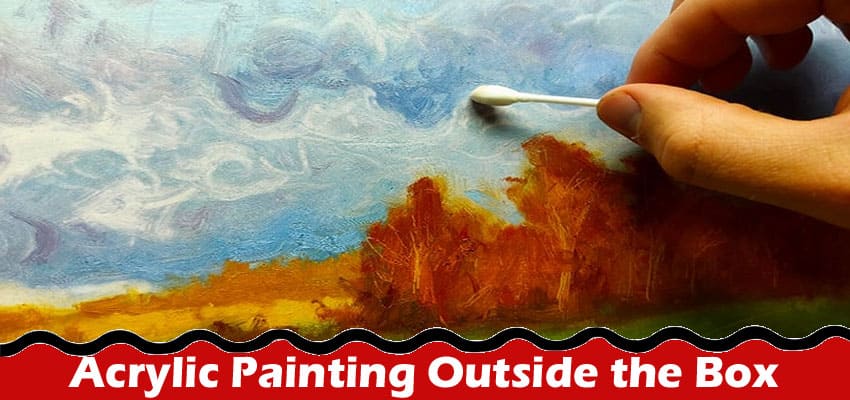Acrylic painting may be used in various ways, making it a popular choice for artists. However, many like to test the limits of acrylic painting by trying out non-conventional techniques. This method can potentially produce daring and original artworks that defy conventional interpretation.
The freedom to experiment and express oneself that comes with nontraditional techniques appeals to artists of all levels of experience. Acrylic painters have more room to explore their imagination and experiment when they break away from the medium’s conventions.
Nontraditional Methods of Acrylic Painting Overview
Acrylic painting can be done in nontraditional ways, allowing artists to experiment and discover novel paths of possibility with the medium. Artists can create one-of-a-kind and forward-thinking works of art by using unique tools and materials, layering and texturing techniques, and merging several artistic mediums.
Exploring abstract notions can also be a method to stretch the boundaries of traditional acrylic painting, which in turn enables artists to convey their thoughts and feelings in unique and unorthodox ways. Employing art as a medium for making social commentary can produce a powerful message and motivate people to engage in critical thought regarding significant matters.
Unconventional Tools and Materials
Acrylic painting is a versatile medium that lends itself to experimentation with various equipment and materials. Here are some out-of-the-ordinary resources:
- Palette knives, sponges, and scrapers can create rough surfaces and layer paint.
- Stencils and masks are used to create patterns and forms.
- You can use toothbrushes, credit cards, and plastic wrap to create unusual textures and effects, utilize household things such as toothbrushes, credit cards, and plastic wrap.
- Found items like leaves, twigs, and fabrics are used to imprint textures onto the canvas.
- Sand, salt, and coffee grounds were used as non-art materials to lend texture and depth to the painting.
- Heat guns or blow dryers can add texture and movement to the paint.
Acrylic paintings can benefit from using uncommon strategies and materials, which can be both a fun and experimental approach to add interest and depth. The lifetime of your artwork depends on the materials and tools you choose, so make sure they are appropriate for acrylic paint.
Experiments with Volume and Texture
Painting with acrylics gives a great deal of room for creative exploration in terms of building layers and creating textures. The following is a list of non-traditional techniques that you can experiment with to create one-of-a-kind and fascinating effects in your acrylic paintings:
Pouring
Interesting patterns and textures can be made by pouring acrylic paint over a canvas and allowing it to spread and blend independently. Straws and brushes are only two examples of instruments you can use to work with the paint.
Stenciling
Adding dimension and texture to your paintings can be accomplished by using stencils to create patterns or shapes on the canvas and then painting over them. You can achieve a more intricate look by stacking multiple stencils.
Impasto
Applying paint in thick layers gives the illusion of depth. The paint can be applied with a palette knife or a brush, and multiple layers can be built to achieve different effects.
Sgraffito
One approach to reveal the underlayers of your work of art is to scratch away at the surface of the piece. Using a toothpick or another pointed instrument, you are able to create intricate patterns.
Collage
You may give your acrylic paintings more texture by including a variety of materials into them, such as paper, cloth, cotton etc. Instead of painting directly onto a blank canvas, try layering scraps of fabric first.
Monoprinting
Acrylic paint on a flat surface, like a plexiglass plate, makes a one-of-a-kind print. The print can then be transferred to the canvas to provide the desired layered and textured look.
Dripping Paint
It’s possible to achieve an odd and abstract look by letting acrylic paint drip onto a canvas, where it can then run and blend together on its own.
Pushing the Boundaries of Traditional Acrylic Painting
Acrylic painters who want to push the medium further must try new approaches, materials, and styles to create groundbreaking works of art. Acrylic painting can be taken beyond its comfort zone in many ways.
- Acrylic mixed media combines acrylic paint with other media, such as oil, watercolor, or ink.
- Applying and reshaping the paint with unconventional implements and mediums.
- Making large-scale paintings or working on atypical surfaces like found objects or installations is one way to play with size and shape.
- Testing out new color schemes or applying color in novel ways.
- Doing philosophical or abstract works and questioning accepted ideas of form and content.
- Using acrylic paint to investigate political and social issues.
Acrylic paintings that go against the accepted conventions of the medium have the potential to surprise and delight viewers while increasing the expressive spectrum of the medium. By experimenting with various methods, mediums, and styles, artists have the opportunity to widen their expression and explore new avenues of creative expression.
Final Thoughts
In conclusion, artists can break from convention and test the limits of acrylic painting by using nonstandard techniques. Acrylic painting’s potential can be greatly expanded by unconventional approaches, such as experimenting with mixed media or investigating social and political subjects. Memorialize Art is the place to get your very own acrylic painting, among the many other mediums the website offers. You will have a wonderful time browsing around and having an Acrylic painting made for you.


